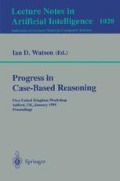Abstract
In the telecommunications domain, reuse of service specifications is a major issue. However, it has proved difficult to modularise services because of the high degree of interaction between them. Direct application of formal logics to the specification of services has proved impractical because of the size of the services. However, much of this complexity stems from the details of implementation of the services; by contrast, the principal behaviours of a service are often approximated by simple varieties of logic which are easily accessible to users. We address the problem of determining, from a library of services, those which might be appropriate for reuse in constructing a new service. Simple behavioural sequences are used to provide features within a CBR system which matches these to behavioural examples supplied by users. By side-stepping the problem of formally specifying the entire service, we aim to promote greater reuse of services while avoiding a commitment to full logical specification.
Non-mathematicians often have difficulty in expressing requirements formally. By using a CBR approach the user can sketch out simple, familiar behaviours and with these examples the system is able to retrieve relevant cases and interactively produce a formal requirements sketch capturing the new required behaviour. A case in the case library encapsulates a particular formalised behaviour in a simple logic which is sufficient to capture the key dynamic behaviours of the domain. With a simulator the user can evaluate the behaviour without being confronted with the formal representation itself. Our domain is telephone features such as call waiting, redirect call, call back. These telephone services are stored in the case library as cases, each consisting of a set of transition rules. In previous papers we have described the general architecture of the system (see for example [Funk & Robertson 1994]). In this paper we focus on matching dynamic behaviour and the formal representation of the cases.
This research was supported by the Marcus Wallenberg Foundation for Scientific Research and Education and ELLEMTEL Telecommunication Systems Laboratories, Sweden.
Preview
Unable to display preview. Download preview PDF.
References
Aamodt, A. and Plaza, E., (1994). Case-Based Reasoning: Foundational Issues, Methodological Variations, and System Approaches. AI Communications, Vol. 7, No 1, pp 39–59.
Bundy, A., (1992). Tutorial notes: reasoning about logic programs. Second International Logic Programming Summer School, LPSS '92. Proceedings, pp. 252–77, Comyn G., Fuchs N.E., & Ratcliffe M.J. (eds.), Springer-Verlag.
Dalianis H. and Hovy E. (1993). Aggregation in Natural Language Generation, The Fourth European Workshop on Natural Language Generation, Proceedings, Pisa, Italy.
Davis, E., (1990). Representations of Commonsense Knowledge, chapters 2 and 3. Morgan Kaufmann.
Echarti, J. P. and Stålmarck, G., (1988). A logical framework for specifying discrete dynamic systems, Technical Report, Ellemtel Telecommunication Systems Laboratories.
Engstedt, M., (1991). A Flexible Specification Language using Natural Language and Graphics. MSc thesis, University of Edinburgh.
Funk, P. J. and Robertson D., (1994). Case-Based Selection of Requirements Specifications for Telecommunication Systems. Second European Workshop on Case-Based Reasoning, Proceedings, Keane M., Haton J. P., Manago, M. (eds.), Chantilly, France, pp. 293–301.
Funk, P. J., (1993). Development and Maintenance of Large Formal Specifications Supported by Case-Based Reasoning. TP26. University of Edinburgh.
Funk, P. J., Raichman, S., (1990) ROS, An Implementation Independent Specification for ISDN, Technical Report, Ellemtel Telecommunication Systems Laboratories.
Gelfond, M. and Lifschitz, V. (1993). Representing action and change by logic programs, Logic Programming, pp. 301–321.
Lewis, H. R. and Papadimitriou C. H., (1981). Elements of theTheory of Computation, Prentice-Hall.
Smyth, B. and Keane M. T., (1993). Retrieving Adaptable Cases, In K-D. Althoff, K. Richter, & S. Wess (eds.), First European Workshop on Case-Based Reasoning. Kaiserslauten: Germany.
Author information
Authors and Affiliations
Editor information
Rights and permissions
Copyright information
© 1995 Springer-Verlag Berlin Heidelberg
About this paper
Cite this paper
Funk, P.J., Robertson, D. (1995). Capturing and matching dynamic behaviour in case-based reasoning. In: Watson, I.D. (eds) Progress in Case-Based Reasoning. UK CBR 1995. Lecture Notes in Computer Science, vol 1020. Springer, Berlin, Heidelberg. https://doi.org/10.1007/3-540-60654-8_24
Download citation
DOI: https://doi.org/10.1007/3-540-60654-8_24
Published:
Publisher Name: Springer, Berlin, Heidelberg
Print ISBN: 978-3-540-60654-3
Online ISBN: 978-3-540-48525-4
eBook Packages: Springer Book Archive

